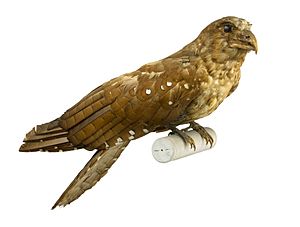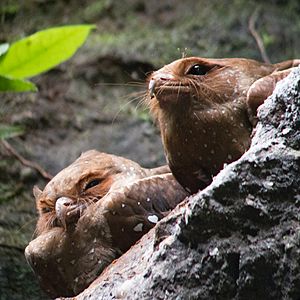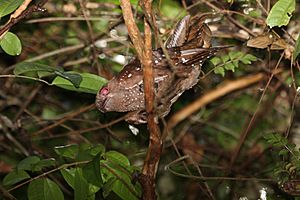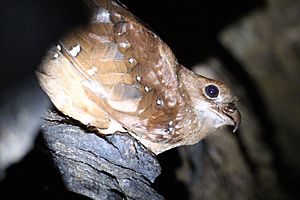Oilbird facts for kids
Quick facts for kids Oilbird |
|
|---|---|
 |
|
| Conservation status | |
| Scientific classification | |
| Genus: |
Steatornis
|
| Species: |
caripensis
|
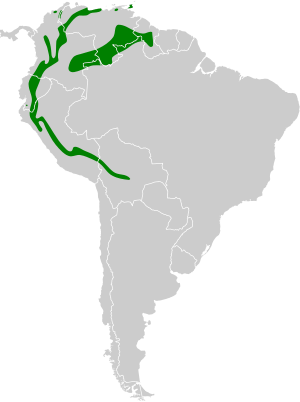 |
|
The oilbird (Steatornis caripensis) is a very special bird. People in its home countries often call it the guácharo. You can find oilbirds in northern South America and on the island of Trinidad. It is the only species in its group, called Steatornis, and its family, called Steatornithidae.
Oilbirds live in large groups inside caves. They are nocturnal, meaning they are active at night. They fly out to eat fruits from oil palm and tropical laurel trees. Oilbirds are the only night-flying birds in the world that eat fruit. They have amazing eyesight for the dark. But they also use echolocation to find their way, just like bats! They make high-pitched clicking sounds that humans can hear.
Contents
About the Oilbird's Name and Family
Oilbirds are related to nightjars. Scientists often group them together. However, nightjars eat insects, but oilbirds only eat fruit. This makes the oilbird very unique. Because of this, it has its own special family (Steatornithidae). Some scientists even think it should be in its own order!
The scientific name caripensis means "from Caripe". This is a place where they were first studied. The name Steatornis means "fat bird". This is because young oilbird chicks get very fat. In Spanish, they are called guácharo or tayo. These names come from local native languages. In Trinidad, some people called them diablotin, which means "little devil" in French. This was probably because of their loud calls. The name "oilbird" comes from the past. People used to catch the chicks and boil them to make oil.
Scientists have found old oilbird fossils. These fossils show that oilbirds used to live in more places around the world. The first fossil was found in Wyoming, USA, in 1987. This ancient oilbird, called Prefica nivea, might not have lived in caves. It also might not have been able to hover like today's oilbirds. Some of the same plants that oilbirds eat today were found near these fossils. This suggests that ancient oilbirds might have eaten the same fruits. They could have helped spread seeds too.
What Oilbirds Look Like
Oilbirds are large, slender birds. They are about 40 to 49 centimeters (16 to 19 inches) long. Their wings can spread up to 95 centimeters (37 inches) wide. An adult oilbird weighs about 350 to 475 grams (12 to 17 ounces). But their chicks can weigh much more, up to 600 grams (21 ounces)! This happens because their parents feed them a lot of fruit before they learn to fly.
Oilbirds have soft feathers, like many birds that fly at night. Their feathers are not as soft as owls' feathers, though. This is because owls need to be silent when hunting. Oilbirds are mostly reddish-brown. They have white spots on their neck and wings. Their lower body is a cinnamon-buff color. It has white, diamond-shaped spots with black edges. These spots are small near the throat and get bigger towards the back. Their stiff tail feathers are a rich brown with white spots.
Their feet are small and not very useful for walking. They mostly use them to hold onto cave walls. Their long wings are special. They allow the oilbird to hover and twist in the air. This helps them fly through the tight spaces in caves. Their wings are designed for slow, careful flight.
Oilbirds have amazing eyes for seeing in the dark. Their eyes are small, but their pupils are very large. This lets them gather a lot of light. In fact, they can gather more light than any other bird! Their eyes have many special cells that help them see in very low light. This means they can see well at night. But they probably don't see very well during the day.
Even with their great night vision, oilbirds also use echolocation. They use it when it's too dark to see. They make sharp, clicking sounds for this purpose. Only a few other birds, like some types of swifts, can do this.
Besides the clicks for echolocation, oilbirds make loud screams in their caves. If you enter a cave with a light, they often make these noisy calls. You might also hear them as they get ready to leave the cave at dusk.
Where Oilbirds Live and Their Home
Oilbirds live in countries like Guyana, Trinidad, Venezuela, Colombia, Ecuador, Peru, Bolivia, and Brazil. They can live from sea level up to 3,400 meters (11,150 feet) high in the mountains.
Oilbirds need very specific places to live. They need caves for breeding and resting. They also need forests nearby with fruit trees. If there are no suitable caves, oilbirds might use narrow gorges or rocky shelters.
For example, one group of oilbirds in Ecuador lived in a canyon. About a hundred birds lived there on ledges protected by plants. Some smaller caves are only used for resting. People used to think oilbirds always stayed in caves. They thought oilbirds never saw daylight. But scientists used GPS trackers on some birds. They found that birds not breeding sometimes rested in trees in the forest. They didn't always stay in caves.
Scientists also found that birds in caves were very active at night. Birds resting in the forest were less active. They think each place has its challenges. Birds in the forest might be more at risk from predators. Birds in caves use a lot of energy competing with other birds. They also spend energy defending their nesting spots.
Oilbirds sometimes move to different areas. They travel to find fruit trees. They have been seen rarely in Costa Rica, Panama, and Aruba. The Guácharo Cave in Venezuela is famous. This is where Alexander von Humboldt first studied oilbirds.
Oilbird Behavior
Oilbirds are nocturnal birds. During the day, they rest on ledges inside caves. At night, they fly out to find fruit outside the cave. As mentioned, scientists used to believe oilbirds only rested in caves. They thought these birds never saw daylight. But studies with GPS trackers showed something new. Non-breeding birds only rested in caves or rock shelters about one night out of three. On other nights, they rested in trees.
The scientists who made this discovery also found something else. Birds resting in caves were very busy throughout the night. However, birds resting in the forest were much less active. They believe each resting place has its own challenges. Birds resting in the forest might be more easily found by predators. Birds resting in caves use a lot of energy. They compete with other birds and defend their nesting and resting spots.
Oilbird Reproduction and Life Cycle
Oilbirds are colonial nesters. This means they build their nests close together in caves. Their nest is a pile of their droppings. It is usually built above water, like a stream or the sea. The female oilbird lays 2 to 4 glossy white eggs. These eggs soon become stained brown. They are round but have a pointed end. They are about 41.2 mm by 33.2 mm in size. The young chicks, called squabs, get very fat before they can fly. They can weigh about a third more than the adult birds!
Oilbird Status and Protection
The Guácharo Cave in Venezuela is very important. It was Venezuela's first national monument. It is now the main part of a national park. Some people think there are 15,000 or more oilbirds living there. Colombia also has a national park named after its "Cueva de los Guácharos" (Oilbird Cave). This park is near the border with Ecuador.
Oilbirds have been seen in many other places along the Andean mountains. This includes places near Ecuador's Cueva de los Tayos and in Brazil. They are known to live as far south as the Carrasco National Park in Bolivia. Dunston Cave, at the Asa Wright Nature Centre in Trinidad, is home to about 200 nesting pairs. The IUCN Red List says the oilbird is of 'Least Concern'. This means it is not currently in danger of disappearing. This was decided in October 2016, even though their population is slowly decreasing.
See also
 In Spanish: Guácharo para niños
In Spanish: Guácharo para niños



